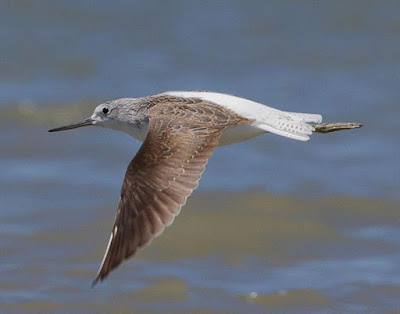Thinking that Friday morning might be OK for birding wasn't a great decision. The broken rainbow that fell from black clouds above made a pretty good pointer to the never ending showers that followed. It was windy too, much more than the Granada forecast and the whole morning felt like September had well and truly arrived.
A Cockerham rainbow
It was two weeks since I last visited Conder Green (25th August) so I headed there first. I'm not sure where the wagtails had roosted overnight but the first stop for many of them was Conder Pool where I counted a remarkable 80+ Pied Wagtails and 2 Grey Wagtails along the far bank. The wagtails were so far away that I'm pretty sure more were hidden out of sight over the bank and behind the pool.
This last week saw a push of Swallows headed south and it was noticeable today how few were around with 70+ feeding over and around the early morning hedgerow the best count by far. Otherwise there were just twos and threes along the lanes towards Cockersands where last broods are still about the farms buildings.
Swallow
The grassy margins of Conder held large numbers of Lapwings, so numerous and so mobile that a count is of 450+ is but an estimate. Once or twice the loose flock erupted into a cloud of flight as if all of those present received the same message of danger at precisely the same moment. Birders call the spectacle a “dread”. The more scientific term for the phenomenon is “Swarm Intelligence” or SI.
“Although there is no centralized control structure dictating how individual agents should behave, local, and to a certain degree random, interactions between such agents lead to the emergence of "intelligent" global behaviour, unknown to the individual agents. Examples in natural systems of Swarm Intelligence include ant colonies, bird flocking, animal herding, bacterial growth, fish schooling and microbial intelligence.”
Other waders and wildfowl today – 32 Redshank, 5 Greenshank, 3 Snipe, 2 Black-tailed Godwit, 2 Common Sandpiper, 14 Teal, 3 Little Egret.
Greenshank
Very evident today was the number of Starlings. This is the time of year when we have an influx of Continental Starlings that spend the winter here in the UK rather than colder parts of Europe. Twice I saw newly arrived Starling flocks pursued by raptors – firstly by a Sparrowhawk and then later by a Merlin. Neither raptor caught their breakfast.
Sparrowhawk
I stopped off at Gulf Lane where I saw the earlier mentioned Merlin. The Merlin had scattered a field full of Lapwings, Starlings and Curlews which is no mean feat for a bird hardly bigger than a Mistle Thrush. The Merlin flew towards the junction and left a dread of waders in its wake as it inspected the field of set-aside where I’d just counted 35 Goldfinches and 20 Linnets.
We have cut a ride for when finch numbers build. We think that the good summer, a glut of natural food together with a prolonged breeding season may have delayed the arrival here of both Linnets and Goldfinches. But when they arrive in numbers we are ready with an already cut catching area to build on the 400+ Linnets ringed during the last two winters.
By now it was raining again, more heavy showers, grey skies and quite windy. I called it a day and headed home to catch up with news, birds and the “real” world.
We seem to have left summer behind but my pal David in Waterloo, Ontario, Canada tells me it was 35 degrees there on Wednesday. You can read about his weather, birds and bird ringing, together with his liking for coffee and cake on his blog Travels With Birds.
Linking today with Anni's Blog and Eileen's Saturday Blog.
Linking today with Anni's Blog and Eileen's Saturday Blog.































